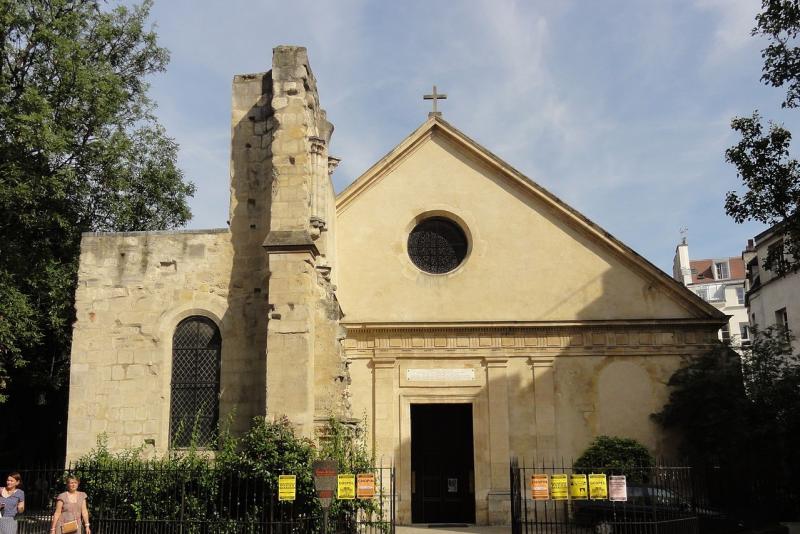

One Day in Paris
To save you from spending a day in the subway, we have put together an eclectic sample of churches that can be visited in 1 day on foot!


Church of Saint-Louis-en-l'Île
The Saint-Louis-en-l'Île church is a French church located on the island of Saint-Louis. The construction of the building was spread out in several stages from 1624 to 1726. A bell tower that stood at the crossroads of the transept was destroyed by lightning in 1740, it was replaced in 1765 by the current bell tower, thirty metres high. Closed in 1791, it was planned to be razed to the ground, but its purchase by the City of Paris in 1817 and its subsequent restoration saved it.

Church of Saint-Paul Saint-Louis
The church was built between 1627 and 1641 by the Jesuits with the financial support of Louis XIII. The inauguration Mass is celebrated by Cardinal Richelieu. It is one of the first churches to emancipate itself from the Gothic tradition. Indeed, the plan is inspired by the Gesù church in Rome. It was first restored in the 19th century by the architect Victor Baltard, then completely renovated in 2012.

Church of Saint-Gervais-Saint-Protais
Saint-Gervais is considered one of the first parishes on the right bank. The church was consecrated in 1420, then enlarged from 1494 until about 1620. The facade is the first of a church to use the classical vocabulary of orders in a monumental way, in accordance with the ancient fashion that prevailed in the 16th and 17th centuries. It was closed in 1793 and reopened in 1795 and shared between Catholics and theophilanthropists until the Concordat. On Good Friday, March 29, 1918, a German shell destroyed part of the nave in the middle of the mass, killing about a hundred people.

Sainte Chapelle
Sainte-Chapelle is a palatine chapel built in 1241-1248 at the request of King Saint-Louis. An emblematic building of the radiant Gothic, the Sainte-Chapelle is classified as a historical monument since 1862, a year before the completion of its restoration. With the Conciergerie, the Sainte-Chapelle is one of the remains of the city's palace, which has extended to the site that houses the current courthouse.

Notre Dame
Notre Dame was built in the Île de la Cité- in the early days of the gothic era, over more than two centuries, from 1163 to the middle of the 14th century. In the heart of the Romantic period, the cathedral was restored between 1844 and 1864 under the direction of the architect Viollet-le-Duc. It is one of the most eminent churches in the world, and the symbol of the city of Paris. It has become the theatre to some of the most notorious novels in literature, celebrated by writers and artists including Victor Hugo. The cathedral Although the monument is a great example of early gothic style, the influence of the Romanesque school is still visible. In 2019, the church was badly damaged by a fire.

Church of Saint-Julien-le-Pauvre
The church of Saint-Julien-le-Pauvre is a medieval church built in the 12th century on the site of a primitive basilica destroyed by the Vikings. The priory to which the church was attached has long been prosperous, and the church has even hosted courses from the University of Paris. The French Revolution led to the transformation of the church into a warehouse. Since 1888, the Greek-Catholic Melkite community made the church its parish church. It remains the centre of the life of the Greek-Catholic Melkite parish in Paris.

Saint-Étienne-du-Mont Church
Saint-Étienne-du-Mont Church was built at the end of the 15th century on the site of a 13th-century church, but its rich Renaissance façade was not completed until 1624. Until the French Revolution, the church housed the relics of Sainte Geneviève, patron saint of Paris. The church also houses an organ from the 1630s.

Panthéon
The construction of the Basilica of Saint Genevieve (a decision taken following Louis XV's vow) began in 1756 and was completed in 1790: the foundations were laid between 1756 and 1764 and the first stone was laid in 1764. Jacques-Germain Soufflot was the architect, assisted by Jean-Baptiste Rondelet, site manager, and Maximilien Brébion. After the Revolution, the building was transformed into a temple dedicated to great men and took the name of Pantheon.

Church of Saint-Sulpice
The Saint-Sulpice church, built between 1646 and 1870, replaced a 12th century sanctuary. The style chosen for the new church is classicism with many Corinthian elements. The walls and vaults of the chapels, but also the arms of the transept, were decorated between 1820 and 1880 by artists such as Alexandre-Denis Abel de Pujol, Auguste-Jean-Baptiste Vinchon and Delacroix. The organ case was made at the end of the 18th century based on Chalgrin's drawings. The organ itself was completely rebuilt by Cavaillé-Coll.

Church of Saint-Germain-des-Près
The church is part of an old Benedictine royal abbey dating from the 6th century. The building was rebuilt by Abbot Morard in the 10th century. The current choir was built in the middle of the 12th century and consecrated by Pope Alexander III. Conventual buildings successively rebuilt during the 13th century. After the Revolution, the church lost its status as an abbey church to become a parish abbey. Reconstructions carried out between 1821 and 1854. Church classified as a historical monument by list in 1862. Remains of the former abbey classified in 1953. Saint-Germain-des-Prés church is the oldest of the great Parisian churches.


